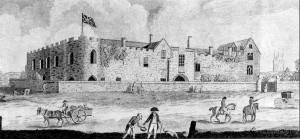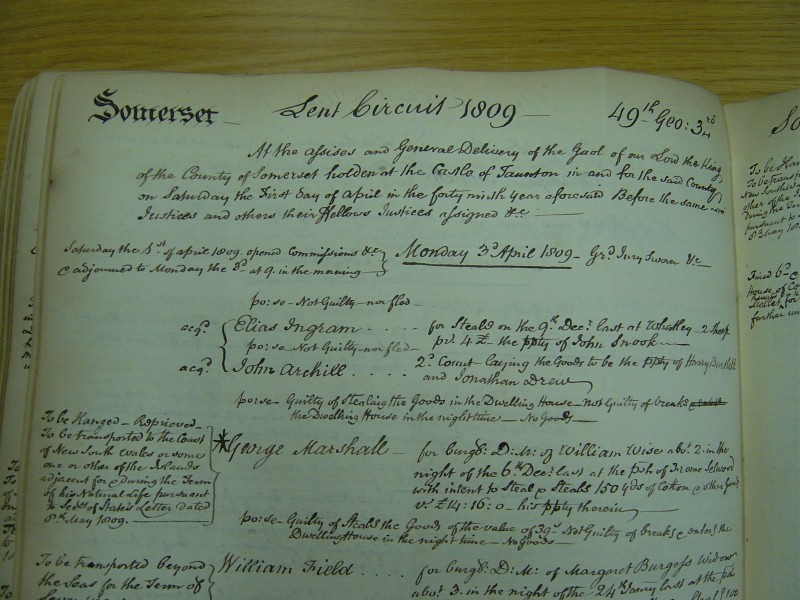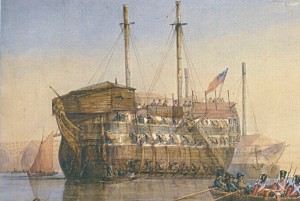My link with George Marshall (1787-1828) is that he was my great great great grandfather, who arrived on the ‘INDIAN’ in 1810. He married Mary McCarroll (1781-1838) in Sydney in 1815.
Part One: England and Transportation. Below.
Part Two: To the New Colony Click here.
Part Three: Marriage and children. Click here.
Part Four: Weaver and Landholder. Click here.
Marshall Outline Descendant Tree. Click here.
PART ONE
ENGLAND and TRANSPORTATION
His Majesty being graciously pleased to extend the Royal Mercy to them
on condition of their being transported to the Coast of New South Wales…..
Earl of Liverpool, Principal Secretary of State 1809.
George Marshall found himself on the wrong side of the law in Frome Selwood, Somerset, England, in 1809. His trial, in Taunton, Somerset on 1 April 1809, led to his transportation to New South Wales on the ‘Indian’, arriving in Port Jackson on 16 December 1810, a mere 22 years after Governor Arthur Phillip established the new colony. His Australian descendants number in the thousands, many of whom can refer to him as their five times great grandfather.
Despite much effort, it has not been possible to find anything on Marshall’s life prior to the trial. His date of birth was either 1781 (Somerset County Council Assizes record [1] states that he was 28 in April 1809); or 1783 (His Absolute Pardon[2], issued in 1827, gives this date).
As to place of birth, there is no record. Given the limited movements of populations in those days, it has been assumed that he grew up locally. The indictment refers to George Marshall as “late of Frome Selwood, Somerset”. The Somerset County Archivist, however, could not find his address or birth details. He wrote that Marshall
“ was committed for trial by the Rev. W. Ireland, Justice of the Peace, who was Vicar of Frome, a town in East Somerset, and that the surname Marshall is to be found there. I have checked a transcript of the church register of baptisms for the years 1775-1785, without finding any reference to the name, and it may be that George and his family lived in another parish near to Frome or, which is very probable, that they belonged to a church other than the Church of England. Nonconformity was strong in Frome, but unfortunately poorly represented in documents.” [3]
But he may not have been a local lad. The only hints, but strong ones at that, to his birthplace are the notations in New South Wales on each of his Conditional Pardon[4] and Absolute Pardon[5] documents, issued nine years apart. These both record “Yorkshire” against “Native Place” It has been interesting to note a further Yorkshire connection in a history of Tambo Vic, which states in a reference to Charles Marshall, George’s son, who settled for part of his life in East Gippsland that “…Marshall always claimed that he was related to Captain Cook, hence the name of the … (Captain Cook) Hotel…”[6]The possibility has been taken no further, but if correct such would add much value to our story. Cook had died on his third voyage only a few years before the birth of George Marshall, but if they were related then at a close level.
Extensive Yorkshire records exist for those who undertake genealogical research, as well as some Somerset records, but with so little background to work with, it has not been possible to commence any meaningful research into the probable local origins of George Marshall or his English family. There are records of some Marshall births in nearby locations in Somerset, but there is inadequate evidence to tie them to George.As to his occupation, Marshall was described as a “labourer” on his indictment document. [7] However, the items he stole from Mr Wise, Clothier – cloths, muslin, stockings, cloaks, neckerchiefs and clothing- suggest that he had some knowledge and experience in the clothing trade. So was he employed by Mr Wise? Further support for the theory that he was experienced in the trade, was his assignment in the Colony to Simeon Lord, as was as his description in his 1815 Marriage Certificate as “Clothier”. The 1822 Muster, by which time he had been pardoned, lists him as a “Cloath (sic) Manufacturer”. Later documents record his sales of cloth and blankets to the Male Orphan Institution, and donation of blankets to the Benevolent Society. When seeking a grant of land at Botany in 1824, Marshall described himself as “ by trade a Clothier and Blanket Maker…” other later documents describe him as ‘weaver.’
His assignment to Simeon Lord, the dominant Sydney woollen goods manufacturer, was consistent with a practice (albeit observed with some inconsistency,) of the Colonial authorities, of allocating to local prospective employers in response to their requests for assignees with particular experience and capabilities. While this does not prove that he was employed in the clothing trade during his time in Somerset, it is persuasive. Though he was convicted on the charge of stealing, he was found “not guilty” on the second charge of breaking in [8]. This could lead one to observe that he may have had (legal) access to the building. Was he therefore an employee? So did he have a key? As mentioned above, the list of items he stole suggested a knowledge of the trade.
We know, therefore, that he was born in 1781 or 1783. We know not where he was born or was brought up, but the records suggest Yorkshire. We do not know when he moved to Somerset or why, or whether he did so with his family, of whom we know nothing. The available evidence suggests he was employed in the clothing trade, probably in Somerset and prior to his arrest. Perhaps, or perhaps not, he may have been employed at the time by Mr William Wise. As to his place in local society, the only evidence we have is his own claim, in an 1825 letter[9] to Governor Brisbane seeking (successfully) a Grant of Land, that he was “reinstated once more in the middle sphere of society” thus implying a middle class status prior to his transportation.
The first and only discovered documented record of his life to that time is available as a result of the robbery on the night of 6 December 1808. William Wise’s shop was within his dwelling house in what was then a substantial town of Frome Selwood, 16 Km south of Bath, in east Somerset. The town is now called Frome. It has a 14 Century parish church, containing the remains of a 10 Century church. Its population by 1840 had reached 12,240. One hundred and fifty years later, it still had woollen mills among its predominantly agricultural industries[10]. At that time, 30 years after the break-in, there were listed, in the local Directory, 18 “clothiers”, though none named Wise, among the several pages of trade and business people[11].
George Marshall, approximately 28, was arrested for the crime and was consequently indicted:
“for burgling the dwelling house of William Wise about 2 in the night of the 6th Decr last at the parish of Frome Selwood with intent to steal, and steals 150 yards of cotton and other goods value £14. 16s .0d. his property therein”. It refers to George Marshall as “late of the Parish of Frome Selwood, Somerset, labourer”. The indictment details the stolen goods as: 150 yards of cotton £7~10s; 40 pairs of worsted stockings £2 ; 6 yds of muslin 12s.; One frock 10s ; 7 yds of “Dowlas” 7s.; 2 woollen cloaks 5s; and 72 neckerchiefs £3. 12s. “[12]
PRO advised that “Marshall’s age and place of birth are not given in the records, In every indictment at the time, however, the place of residence is shown as the same as the place of the crime, so he may not have lived in Frome Selwood.[13]
The trial records were recorded on vellum which is kept, in excellent condition, in the Public Records Office (PRO) in Kew, UK. The trial was set down for April 1, 1809 in the Taunton Castle, in the County Town of Taunton, some 70 Km to the south west.
The Schedule of Prisoners in Westchester Gaol for Trial included at item 12 the following:.
George MARSHALL. Committed by W. Ireland, Clerk, charged on the Oath of William Wise and other Proof on a strong suspicion of having on the sixth day of December last, feloniously and privately stolen, taken and carried away out of the Shop within the Dwelling House of said William Wise at Frome Selwood, eight remnants of printed cotton, thirty pair of worsted stockings, about half a piece of Chambery muslim, one carters frock, a quantity of Dowlas cloth cut-out for the purpose of making two other carters frocks, two long cloaks, and five dozen of handkerchiefs, the goods of the said William Wise.
The Warrant was dated Jan 2, 1809. On the reverse was noted: “William Wise, Mary Wise, William Pickford, Mary Pickford, William Alexander. 5 sworn in Court.” [14] Presumably these were set to be called as witnesses in the case, where Marshall stood trial on two counts, stealing goods, as well as breaking in to the house.
The Court duly convicted Marshall on the first count but declared him not guilty on the other. The following two notations were made across the vellum document:
“po se[15]: Guilty of stealing the goods in the Dwelling House. 2. Not guilty of breaks the Dwelling House in the night time. No goods”, and
“To be hanged. Reprieved- To be transported to the Coast of New South Wales or some one or other of the Islands adjacent, for and during the term of his natural life pursuant to the Secretary of State’s letter dated 8 April, 1809.”
The issue by the Secretary of State of the reprieve within a few days reflects practice at the time, whereby imposition of the death penalty, with immediate reprieve to Life and Transportation were quite common, reflecting a Government policy rather than individual judicial decision. At the time, a great number of what we may now regard as petty offences, such as “picking pockets of more than a shilling”, “house breaking by day or night”, “burglary” and “stealing articles worth £2 in any house or on a river” were among the crimes punishable by death.[16] The courts, which interpreted a law which equated such misdemeanors with the crime of “attempting to kill a Privy Councillor” had no latitude, at least until some years into the nineteenth century. The act of reprieving prisoners on condition they agreed to be transported was very common during the period of the American Colonies. Transportation was economical to the Government. The prisoner had to work for the public good. He/she was “assigned” to a civilian employer, or sometimes retained in Government work gangs. Consequently the practice continued after New South Wales and Van Dieman’s Land replaced the Americas as the destination.[17]
Consistent with the foregoing, the Court’s formal decision and instructions re transportation reads as follows:
“….and whereas…..George Marshall, (and others)……….have been severally convicted of Felony for which they are excluded from the benefit of Clergy, but His Majesty being graciously pleased to extend the Royal Mercy to them on condition of their being transported to the Coast of New South Wales or some one or other of the Islands adjacent….for and during the term of their respective natural lives, and such intention being signified to the Court by the Earl of Liverpool, one of His Majesty’s Principal Secretaries of State. The Court hath allowed to the said last named offenders the benefit of such Conditional pardon and hath ordered that they be immediately transported accordingly.”[18]
The April Taunton trials were reported, with little detail, in the local press.:
Stephen Hockey for robbing the shop of R Wilcox; James Biggin for wounding Henry Collier with a bill-hook; Elias Ingram and John Archill for stealing two sheep from Mr Snook; George Marshall for stealing cotton from Mr Wise; James Nicholls and Wm Few for robbing James Hitchins on the highway near the Bath Bridge; John Godding for stealing two lambs; Isaac Elliott for robbing E Andrews on the highway; Thos Baker, only twelve years old, for burglary; Thos Coombs age 18, for breaking into and stealing money from the house of J Parsons of Keyntham; and James Taylor for the wilful murder of John Dyer, coachman of this city; received a sentence of death but were reprieved, except Taylor who was left for execution. John Clatworthy and Wm Webber for uttering a forged note were sentenced to 14 years transportation; Mary Fuller for stealing a child; Wm Field for stealing a pig; and Wm Smith for stealing two handkerchiefs, to seven years transportation.”[19]
All except James Taylor, the murderer – who was promptly executed a week after the trial – were immediately reprieved. Many convicted that day were destined to accompany Marshall to the other side of the world. Marshall, as well as most of the others listed above as convicted at the same time, was transferred on 1 June, 1809 to the hulk ‘Retribution’ at Woolwich, in the Thames. [20] Read his description of the harsh life on the ‘Retribution’ by James Vardy Vaux. She was an elderly Spanish 32 gun warship by origin and the largest of all the hulks at the time.[21]
The hulks were crowded and unhealthy. From the early 18th century until the American Revolution, Britain transported convicts each year to Maryland and Virginia. The North American colonies declared their independence in 1776 and closed their ports to British prison ships. A crisis in the British criminal justice system followed. Britain started converting old merchant ships and naval vessels into floating prisons known as hulks. Convicts spent time on the hulks before being transported to Australia, the new destination for Britain’s convicts. By the 1776 Act, convicts …”shall be punished by being kept to hard labour in the raising of sand, soil and gravel, and cleansing of the River Thames…” So they were put to work building docks, quays and yards for the Royal Arsenal at Woolwich, nicknamed the Warren.
What confronted Marshall on the ‘Retribution’, was surely a living hell. James Hardy Vaux, who came on board three weeks after Marshall, wrote of these conditions. He and Marshall had to live through the twelve months on board, during which time 8% of those embarked died. See Vaux’s description in the Box at the end of this chapter.
This situation of incarceration was, even for the time, sub human, as found by a British Parliamentary Committee. It was of no consolation to Marshall that improvements were implemented shortly after, as a result of a British Parliamentary Committee enquiry. [22]
Of the Taunton group on board the hulk, sadly, the twelve year old Thomas Baker, sentenced to transportation despite his young age, died on 29 March 1810. John Archill remained on board and died there on 24 November 1810 after Marshall had left. But Clatworthy aged 22, Hockey 26, Ingram 38, Coombs 18, Godding 19, Nicholls 21, Few 20, Webber 51, Elliott 20, Field 59, Smith 34 and George Marshall then aged 28, all boarded the ‘Indian’ on 15 June 1810.
The ‘Indian’ had been fitted out at Deptford for 200 prisoners. On 15 June, at Longreach, a few miles below Woolwich in the Thames, she picked up Marshall and 54 other convicts, including James Hardy Vaux, from the ‘Retribution’. The next day, the ship moved on to Gravesend for three days, and then to the Nore Light outside the Thames entrance where, without dropping anchor, it took on 45 more from the hulk “Zeeland” docked at nearby Sheerness. She arrived at Spithead, near Portsmouth, three days on. There she picked up 100 more prisoners from the hulks at Portsmouth and Langston Harbour.[23] About two weeks later, on 18 July 1810, fifteen months after George Marshall’s trial, the ‘Indian’, carrying him and these 199 other convicts, set out for Port Jackson.
For George Marshall, Part Two, click here.
- Somerset County Archivist to Joan Dawes 28 October 1981.↵
- SRNSW 2/1907.1 No 10. Reel 800 P.21,22 .↵
- Somerset County Archivist to Joan Dawes 28 October 1981.↵
- [Col Sec Register of Conditional Pardons 1791-1825. Reel AO 774 (4/4430) p117)↵
- SRNSW 2/1907.1 No 10. Reel 800 P.21,22 .↵
- “The Tambo Shire Centenary History” by John D Adams 1981. Page 101.↵
- PRO ASSI 25/7↵
- PRO ASSI 25/7/4 1 April 1809.↵
- SRNSW Fiche 3143; 4/1843A No. 512 pp. 365-8). [Reel 1079 Memorial 512. Ref. 4/1843]↵
- Frome – Columbia Gazetter↵
- General Directory, Somerset 1840. Pub. by Wm Bragg.↵
- PRO ASSI 25/7 and Letter P J Seaman, Search Department, PRO to Joan Dawes 1 July, 1982.↵
- Letter P J Seaman, Search Department, PRO to Joan Dawes 1 July, 1982.↵
- PRO ASSI 25/7/4↵
- PRO Guides state: “po se” is a Latin abbreviation for “ponit se super
patriam” meaning “puts himself on the country”, ie. Opts for jury trial and
pleads not guilty.↵ - The Foundation of Australia. Eris O’Brien. Appendix A.↵
- Convicts and The Colonies. A G L Shaw.↵
- PRO ASSI 24/28 Lent Circuit 1809.↵
- BATH Chronicle Thursday April 13, 1809↵
- PRO HO(/4. AJCP Reel 4879. Return of convicts…..put on board the Retribution hulk at Woolwich.↵
- Vaux, Notes edited by Noel McLachlan↵
- BPP 1810-1811 (199) III, 567 and (217) III, 691.↵
- The Memoirs of James Hardy Vaux. Written by Himself. 1819.↵


